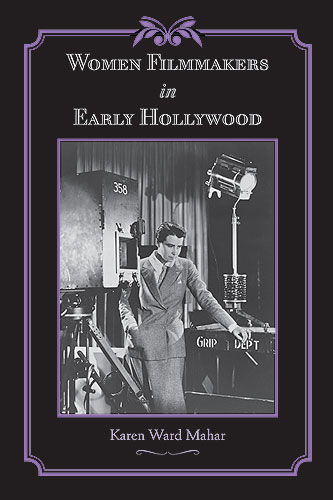(Johns Hopkins University Press, 336 pages, $45)
By Karen Ward Mahar
 Here's a test: Name 10 successful women directors working in Hollywood between 1896 and 1990. Ida Lupino...Dorothy Arzner... Well, the list usually dries up long before 10. Like black filmmakers in the years before Spike Lee’s Do the Right Thing blew open the studio gates, women filmmakers tend to view their full participation in Hollywood as a utopian ideal located firmly in the future.
Here's a test: Name 10 successful women directors working in Hollywood between 1896 and 1990. Ida Lupino...Dorothy Arzner... Well, the list usually dries up long before 10. Like black filmmakers in the years before Spike Lee’s Do the Right Thing blew open the studio gates, women filmmakers tend to view their full participation in Hollywood as a utopian ideal located firmly in the future.
Karen Ward Mahar, however, informs us that now-forgotten women filmmakers of the silent era were often as important, influential and commercially successful—and as well paid—as their male counterparts; this at a time when women still lacked the vote. Director-writer-stars like Lois Weber, Ruth Roland, Helen Holmes and Dorothy Davenport made critically esteemed and successful films throughout the teens and 1920s, and were the equals of such male directors as D.W. Griffith and C.B. DeMille.
Mahar’s point is that both pre- and early Hollywood filmmaking drew its working model from the bohemian egalitarianism of late-19th-century theater, where gender roles remained fluid. In this environment, women were freer to rise from supporting roles and backroom technical jobs to become writers, actresses and even directors. They made the usual cliffhanger thrillers and anarchistic slapstick, but also created films that highlighted women’s issues such as birth control, white slavery, unwed pregnancy and domestic abuse.
It was only, Mahar argues, the corporatization of Hollywood at the close of the sound era—the moment when Wall Street started calling the shots at the studios, vertically integrating the production/distribution/exhibition monopoly, and applying a more “masculine” business ethic—that finally stripped women directors of the prominence they had enjoyed. Thoroughly researched, rich in illustrations and powerfully written (with little recourse to academic jargon), Mahar’s book offers stirring revelations that illuminate a forgotten pioneering spirit among early women filmmakers.
Review written by John Patterson.